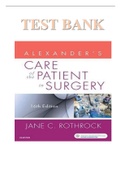Exam (elaborations)
TEST BANK FOR ALEXANDERS CARE OF THE PATIENT IN SURGERY 16TH EDITION BY ROTHROCK
TEST BANK FOR ALEXANDERS CARE OF THE PATIENT IN SURGERY 16TH EDITION BY ROTHROCK Table Of Contents Unit 1: Foundations for Practice 1. Concepts Basic to Perioperative Nursing 2. Patient Safety and Risk Management 3. Workplace Issues and Staff Safety 4. Infection Prevention and Control ...
[Show more]




